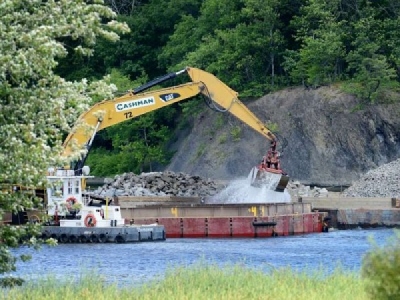
Posted on January 1, 2019
The state launched a sampling effort in summer 2017 to assess the contamination left behind after years of dredging, which was required by EPA in order to meet the goals of a 2002 Record of Decision. The last study included both surface sediment and fish samples. The state also submitted comments rejecting a five-year review by the EPA that concluded dredging had sufficiently remediated the river to a level that would be protective of public health and the environment.
“A remedy that fails to meet its goals is not protective,” said Basil Seggos, commissioner of the state Department of Environmental Conservation. “EPA has a legal and moral obligation to complete the work they started and direct GE to meet the cleanup goals set when the dredging remedy was selected.”
Mark Behan, a spokesman for General Electric, said Thursday that DEC’s own findings show that dredging along the 40-mile stretch from Fort Edward to Troy has been successful.
Almost all of the sediment samples taken by DEC came back with levels below EPA-set criteria for the project, he said. Levels in the water have dropped at “every single monitoring station” along the upper Hudson by as much as 78 percent, he said.
“Dredging is very clearly working,” he said. “That’s demonstrated conclusively by the data, and it’s achieving the goals that both EPA and New York sought and predicted.”
New York disagrees. DEC sampling of nearly 1,700 locations confirmed that elevated levels of PCBs remain in the surface sediment of the river. In many areas, it said, concentrations exceed the 1 part per million cleanup level typically used by the department for sediment cleanup projects.
Overall, the average sediment PCB concentration varied significantly between different reaches of river, it said, indicating there are still certain areas in the upper Hudson where contaminated sediments remain.
Department staff also collected nearly 230 fish samples and evaluated fish data generated by the EPA and GE during and after the dredging project, finding that PCB concentrations in fish are not recovering at the rate anticipated by EPA. The average fish concentrations in the upper Hudson in the two years after dredging are essentially the same as concentrations before the start of the cleanup, DEC said.
The concentrations documented in the ongoing fish sampling after dredging, 1.2 parts per million, is three times higher than the targeted concentration EPA anticipated reaching five years after dredging, or in 2020.
In addition, DEC found that fish PCB concentrations in the lower Hudson have not recovered as a result of remedial work in the upper Hudson. PCB concentration in the estuary, particularly south of the city of Albany, have remained nearly constant for the last several years and show no rate of improvement, DEC said.
New York is calling on the EPA to direct GE to collect additional data to determine where and how much further sediment cleanup is needed. It’s also calling for GE to fund a full investigation of the lower Hudson.
EPA officials said Thursday they’re grateful for New York’s input, and look forward to reviewing its report.
“We will consider their input and conclusions as we move forward with our upcoming decisions on the Certification of the Completion of the Remedial Action, and separately, the Five-Year Review.”
The agency said it expects to finalize those decisions in early 2019.
Source: timesunion





